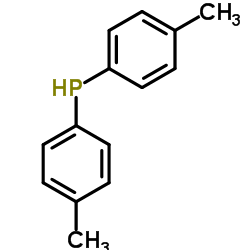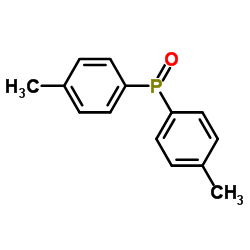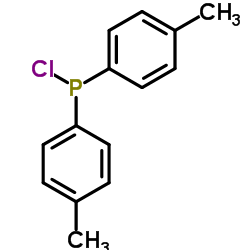Bis(4-methylphenyl)phosphine
Modify Date: 2024-01-03 18:04:48

Bis(4-methylphenyl)phosphine structure
|
Common Name | Bis(4-methylphenyl)phosphine | ||
|---|---|---|---|---|
| CAS Number | 1017-60-3 | Molecular Weight | 214.243 | |
| Density | N/A | Boiling Point | 305.8±35.0 °C at 760 mmHg | |
| Molecular Formula | C14H15P | Melting Point | N/A | |
| MSDS | N/A | Flash Point | 138.8±25.9 °C | |
| Name | Di-p-tolylphosphine |
|---|---|
| Synonym | More Synonyms |
| Boiling Point | 305.8±35.0 °C at 760 mmHg |
|---|---|
| Molecular Formula | C14H15P |
| Molecular Weight | 214.243 |
| Flash Point | 138.8±25.9 °C |
| Exact Mass | 214.091141 |
| PSA | 13.59000 |
| LogP | 2.93270 |
| Vapour Pressure | 0.0±0.6 mmHg at 25°C |
|
Section 1: Product Identification Chemical Name:Di-p-tolylphosphine, 99% CAS Registry Number:1017-60-3 Formula:(CH3C6H4)2PH EINECS Number:none Chemical Family:organophosphine ligand Synonym:none
Section 2: Composition and Information on Ingredients IngredientCAS NumberPercentACGIH (TWA)OSHA (PEL) Title Compound1017-60-3100%no datano data Section 3: Hazards Identification Harmful by inhalation, in contact with skin and if swallowed. May ignite spontaneously on contact with air. Emergency Overview: Contact with skin may result in severe chemical burns. Primary Routes of Exposure:Skin and inhalation Eye Contact:May cause mild to severe irritation of the eyes. Skin Contact:Harmful in contact with skin. May cause mild irritation of the skin, or thermal burns if ignited. Inhalation:Harmful by inhalation. Inhalation may lead to dizziness and headaches. Harmful if swallowed. Ingestion is an unlikely mode of entry as the material is pyrophoric and has a noxious Ingestion: odor. Acute Health Affects:Harmful by inhalation, in contact with skin and if swallowed. Chronic Health Affects:No information available on long term exposure to this material. NTP:No IARC:No OSHA:No SECTION 4: First Aid Measures Immediately flush the eyes with copious amounts of water for at least 15 minutes. A victim will need Eye Exposure: assistance in keeping their eye lids open. Get immediate medical attention. Wash the affected area immediately with water. Remove contaminated clothing if necessary. Seek medical Skin Exposure: assistance if irritation persists. Remove victim to fresh air immediately. Keep the victim lying down and warm. Give oxygen as soon as Inhalation: possible. If shock occurs, respond with appropriate first aid. Transport the victim to a hospital. Seek medical attention immediately. Keep the victim calm. Give water to dilute the toxin (only if conscious). Ingestion: Induce vomiting only if directed by medical personnel. SECTION 5: Fire Fighting Measures Flash Point:no data Autoignition Temperature:Pyrophoric Explosion Limits:Pyrophoric Extinguishing Medium:carbon dioxide, dry powder or foam The pyrophoric liquid may reignite. Fire fighters should be equipped with an approved positive pressure Special Fire Fighting Procedures: self-contained breathing apparatus and full protective clothing. Hazardous Combustion andIf involved in a fire this material may emit toxic organic fumes and vapors of phosphorus pentoxide. Decomposion Products: Unusual Fire or Explosion Hazards: Spontaneously flammable in air, especially in contact with organic matter such as paper or cloth. SECTION 6: Accidental Release Measures 'The material may ignite spontaneously in air. Avoid static discharge. Burning material may release toxic fumes. In case of poor ventilation, leave the area unless fitted with a self-contained breathing apparatus. Spill and Leak Procedures: Small spills can be mixed with ground limestone, sodium bicarbonate, or other suitable absorbents, swept up, and held in a closed metal can. SECTION 7: Handling and Storage Store in a tightly sealed container under an inert atmosphere of nitrogen or argon. Keep away from heat. Handling and Storage:Material should be transferred under an inert atmosphere of nitrogen or argon in a efficient fume hood. Fire may occur in emptied container and transfer lines. SECTION 8: Exposure Controls and Personal Protection Always wear approved safety glasses. When handling this substance wear a face shield as added protection. Eye Protection: Skin Protection:Wear protective clothing and gloves. Consult with glove manufacturer to determine the proper type of glove. Ventilation:Material has a pungent odor. Always handle material in an efficient fume hood. If ventilation is not available a respirator should be worn. The use of respirators requires a Respirator Respirator: Protection Program to be in compliance 29 CFR 1910.134. Ventilation:Material has a pungent odor. Always handle material in an efficient fume hood. Additional Protection:Wear a full face shield, flame resistant lab apron and suitable gloves. SECTION 9: Physical and Chemical Properties Color and Form:colorless liq. Molecular Weight:214.25 Melting Point:no data Boiling Point:no data Vapor Pressure:no data Specific Gravity:no data Odor:pungent and noxious odor Solubility in Water:insoluble SECTION 10: Stability and Reactivity Stability:air-sensitive liquid - pyrophoric Hazardous Polymerization:no hazardous polymerization Contact with air. Material may spontaneously ignite, especially in the presence of organic matter such as Conditions to Avoid: paper or cloth. Incompatibility:oxidizing agents, halogens, air (pyrophoric), halocarbons, sulfur. Decomposition Products:carbon dioxide, carbon monoxide, organic vapors, and phosphorus pentoxide. SECTION 11: Toxicological Information RTECS Data:No information available in the RTECS files. Carcinogenic Effects:No information available. Mutagenic Effects:No information available. Tetratogenic Effects:No information available. SECTION 12: Ecological Information Ecological Information:No information available. SECTION 13: Disposal Considerations Disposal:Dispose of this material according to local, state and federal regulations. SECTION 14: Transportation Shipping Name (CFR):Pyrophoric liquids, organic, N.O.S. Hazard Class (CFR):4.2 Additional Hazard Class (CFR):NA Packaging Group (CFR):I UN ID Number (CFR):UN# 2845 Shipping Name (IATA):Forbidden Hazard Class (IATA):NA Additional Hazard Class (IATA):NA Packaging Group (IATA):NA UN ID Number (IATA):NA SECTION 15: Regulatory Information TSCA:not listed on the TSCA inventory SARA (Title 313):not regulated by SARA 313 Second Ingredient:none SECTION 16 - ADDITIONAL INFORMATION N/A |
| Risk Phrases | 17-34 |
|---|---|
| Safety Phrases | 16-26-27-36/37/39 |
| RIDADR | UN 2845 |
| HS Code | 2902909090 |
|
~% 
Bis(4-methylphe... CAS#:1017-60-3 |
| Literature: Organic Letters, , vol. 7, # 19 p. 4277 - 4280 |
|
~% 
Bis(4-methylphe... CAS#:1017-60-3 |
| Literature: Organic Letters, , vol. 7, # 19 p. 4277 - 4280 |
|
~% 
Bis(4-methylphe... CAS#:1017-60-3 |
| Literature: Journal of the American Chemical Society, , vol. 95, p. 210 - 214 |
| HS Code | 2902909090 |
|---|---|
| Summary | 2902909090 other aromatic hydrocarbons。Supervision conditions:None。VAT:17.0%。Tax rebate rate:9.0%。MFN tariff:2.0%。General tariff:30.0% |
| Bis(4-methylphenyl)phosphine |
| Phosphine, bis(4-methylphenyl)- |
| bis(4-methylphenyl)phosphane |


